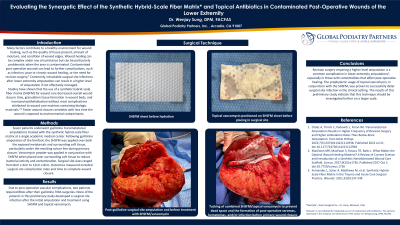Case Series/Study
(CS-135) Evaluating the synergetic effect of the synthetic hybrid-scale fiber matrix<sup>*</sup> and topical antibiotics in contaminated post-operative wounds of the lower extremity.

Many factors contribute to a healthy environment for wound healing, such as the quality of tissue present, amount of moisture, and condition of wound edges. Wound healing can be complex under any circumstance but can be particularly problematic when the area is contaminated. Contaminated wounds can lead to further complications, such as infection, poor or chronic wound healing, or amputation. Ultimately, if not effectively managed, an amputation to the affected area may be necessary to obtain a better prognosis for the patient’s overall health.
Studies have shown that the use of a synthetic hybrid-scale fiber matrix for wound care decreased overall wound closure time, granulation tissue formation in wound beds, and increased epithelialization without most complications attributed to wound care matrices containing biologic materials.1,2 Faster wound closure correlates with less time the wound is exposed to environmental contaminants.
Methods:
Six patients underwent guillotine amputations treated with the synthetic hybrid-scale fiber matrix at a single academic medical center. The synthetic fiber matrix was applied over exposed bone and used as a conduit for topical vancomycin before soft tissue rearrangement and primary closure of the surgical site. Surgical site sizes ranged from 8cm x 4cm to 12cm x 8cm. Sequential wound photographs are taken approximately every two weeks for 12 weeks. Outcomes measured included surgical site complication rates and time to complete wound closure.
Results:
Each patient received one application of the synthetic hybrid-scale fiber matrix with topical vancomycin at the time of amputation. All patients are currently at two to eight weeks post-amputation. Due to ongoing treatment, final outcomes will be collected at 12 weeks post-operatively.
Discussion:
This case series aims to represent a synthetic alternative to biologic wound care treatments in reconstructive procedures of the lower extremity. Treatment with the synthetic hybrid-scale fiber matrix in conjunction with topical vancomycin is predicted to result in enhanced wound healing without significant complications.
Trademarked Items: *Restrata®, Acera Surgical Inc., St. Louis, MO
References: 1. MacEwan MR, MacEwan S, Kovacs TR, Batts J. What Makes the Optimal Wound Healing Material? A Review of Current Science and Introduction of a Synthetic Nanofabricated Wound Care Scaffold. Cureus. 2017;9(10):e1736. Published 2017 Oct 2. doi:10.7759/cureus.1736
2. Fernandez L, Schar A, Matthews M, et al. Synthetic Hybrid-Scale Fiber Matrix in the Trauma and Acute Care Surgical Practice. Wounds. 2021;33(9):237-244.

.png)